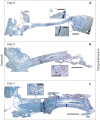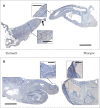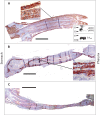Striated myogenesis and peristalsis in the fetal murine esophagus occur without cell migration or interstitial cells of Cajal
- PMID: 18784410
- PMCID: PMC2814024
- DOI: 10.1159/000155225
Striated myogenesis and peristalsis in the fetal murine esophagus occur without cell migration or interstitial cells of Cajal
Abstract
Esophageal striated myogenesis progresses differently from appendicular myogenesis, but the mechanism underlying this process is incompletely understood. Early theories of transdifferentiation of smooth muscle into striated muscle are not supported by transgenic fate-mapping experiments; however, the origin of esophageal striated muscle remains unknown. To better define the process of striated myogenesis, we examined myogenesis in murine fetal cultured esophageal whole-organ explants. Embryonic day 14.5 (E14.5) esophagi maintained a functional contractile phenotype for up to 7 days in culture. Striated myogenesis, as evidenced by myogenin expression, proceeded in a craniocaudal direction along the length of the esophagus. Esophageal length did not change during this process. Complete, but not partial, mechanical disruption of the rostral esophagus inhibited myogenesis distally. Addition of fibroblast growth factor-2 (FGF-2) to the culture media failed to inhibit striated myogenesis, but attenuated smooth muscle actin expression and reduced peristaltic activity. Inhibition of c-kit failed to inhibit peristalsis. These results suggest that striated myogenic precursors are resident along the entire length of the esophagus by day 14.5 and do not migrate along the esophagus after E14.5. Induction of myogenesis craniocaudally appears to require physical continuity of the esophagus and is not inhibited by FGF-2. Finally, peristalsis in E14.5 esophagi appears not to be regulated by interstitial cells of Cajal.
(c) 2008 S. Karger AG, Basel.
Figures





References
-
- Coffin J.D., Florkiewicz R.Z., Neumann J., Mort-Hopkins T., Dorn 2nd G.W., Lightfoot P., German R., Howles P.N., Kier A., O'Toole B.A. Abnormal bone growth and selective translational regulation in basic fibroblast growth factor (FGF-2) transgenic mice. Mol Biol Cell. 1995;6:1861–1873. - PMC - PubMed
-
- David S.G., Cebrian C., Vaughan E.D., Jr., Herzlinger D. c-kit and ureteral peristalsis. J Urol. 2005;173:292–295. - PubMed
-
- Jones N.C., Fedorov Y.V., Rosenthal R.S., Olwin B.B. ERK1/2 is required for myoblast proliferation but is dispensable for muscle gene expression and cell fusion. J Cell Physiol. 2001;186:104–115. - PubMed
-
- Kablar B., Tajbakhsh S., Rudnicki M.A. Transdifferentiation of esophageal smooth to skeletal muscle is myogenic bHLH factor-dependent. Development. 2000;127:1627–1639. - PubMed
-
- Kato S., Muraishi A., Miyamoto T., Fox J.C. Basic fibroblast growth factor regulates extracellular matrix and contractile protein expression independent of proliferation in vascular smooth muscle cells. In Vitro Cell Dev Biol Anim. 1998;34:341–346. - PubMed
Publication types
MeSH terms
Grants and funding
LinkOut - more resources
Full Text Sources
Other Literature Sources

